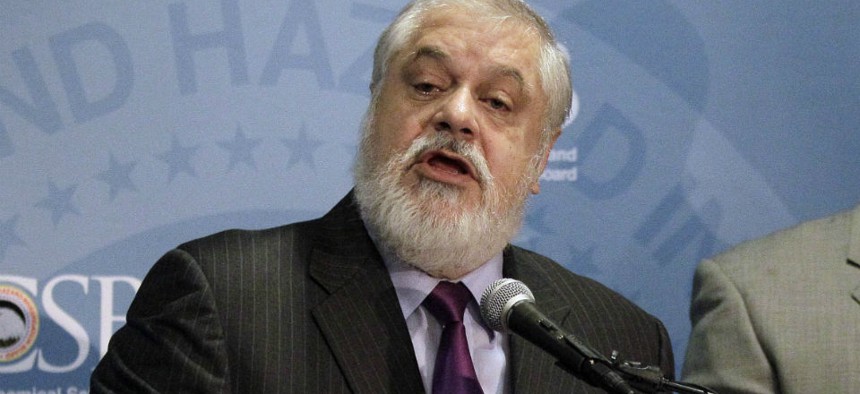
Rafael Moure-Eraso, chairman of the Chemical Safety Board, discusses dust explosions in 2011 at the Hoeganaes Corp. plant in Gallatin, Tenn. Mark Humphrey/AP File Photo
Chemical Safety Board Chief Warns of Deadly Factory Explosions
The embattled chairman is frustrated by the glacial pace of efforts to regulate manufacturing dust.
The embattled chairman of the independent Chemical Safety Board took to the pages of the New York Times last week to step up pressure on federal workplace health regulators to issue a new rule on dangerous dust.
Rafael Moure-Eraso, whose management troubles prompted calls for his resignation at a House hearing in June, highlighted the recent explosion in a Chinese metal products plant that killed 75 people and injured 185.
In the United States, from 2008 to 2012, the board documented 50 combustible dust accidents that led to 29 fatalities and 161 injuries.
“Following a study that our board conducted in 2006,” wrote the chairman of the agency that evaluates other agencies’ regulations, “we recommended that [the Occupational Safety and Health Administration] establish a comprehensive combustible dust regulatory standard for all industries. The following year, it developed an enhanced enforcement program, but the critical component—a national standard with clear requirements—has yet to be created,” Moure-Eraso wrote.
“Despite the fact that a dust standard was one of the Obama administration’s earliest regulatory initiatives, there has been little progress because of a daunting rule-making process. Since 1980, a series of laws, executive orders and judicial barriers have virtually paralyzed the government’s ability to issue new safety standards. According to a nonpartisan congressional study, the process can take nearly 20 years from start to finish,” he wrote. “Given those conditions, is it any wonder that a recent RAND Corporation report found that American workers are three times more likely than their British counterparts to die on the job?”
Moure-Eraso went on to quote OSHA Director David Michaels telling NBC News that “We have a standards process that is broken.”
Asked for a response, an OSHA spokesman told Government Executive, “We are continuing our efforts to move forward on combustible dust rulemaking, and OSHA has also put special emphasis on controlling combustible dust hazards through a national emphasis program, education and outreach.”
The Labor Department agency’s agenda anticipates a new rule initiated under the Small Business Regulatory Enforcement Fairness Act at the end of 2014.







